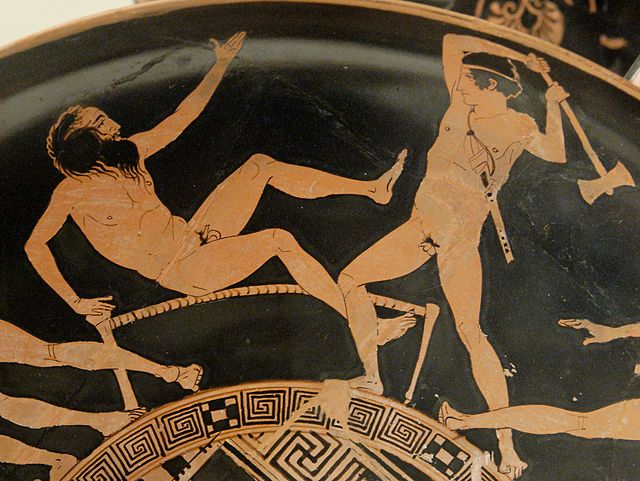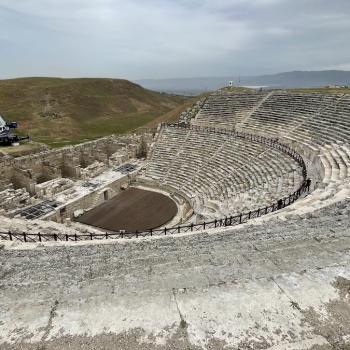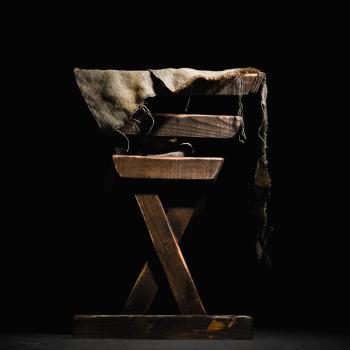
Procrustes, the maniacal son of Poseidon, violently forced strangers to lie in an iron bed. As the Greek legend is told, if the stranger’s limbs protruded over the bed, Procrustes amputated them. If the stranger’s body was too short, Procrustes stretched the limbs until he fit. In all cases, the forced conformity of the stranger’s body to Procrustes’ iron bed resulted in death. Ultimately, the hero Theseus forced Procrustes to make his own body fit to his bed and he subsequently died a similar death as his strangers.
The Procrustean bed became a metaphor for forcing someone or something to conform to an unnatural system. In many ways, we see this sort of systemic prejudice in the manner in which we do church. Perhaps, as we observe in early Christian history, the pastor- and building-centric church is such an iron Procrustean bed.
The Procrustean “Pastor”
The rise of the term “pastor” in the historical development of the church occurs during the fourth century when the role of bishop and elders began to be described as shepherds (gr. poimen). The early history of the church shows us that some shepherds also served as prophets and teachers. While surprisingly absent as a prominent role in the first to third centuries, “pastor” has taken on an importance mostly solidified after the Reformation and especially after identifying 1 & 2 Timothy and Titus as “pastoral epistles” in the 18th century (Guthrie 1990, 17).
However, as we have seen in early written histories of the church in the fourth century, the word “pastor” or “shepherd” occurred infrequently. For three hundred years, we simply do not have significant evidence for anything resembling what “pastor” became with the emergence of Protestantism.
Nevertheless, the New Testament teaches us that the early Christ-followers adapted to culture. In this sense, it is perfectly acceptable to posit that “pastor” became an adapted form of leadership. Yet, somewhere in its adaptation, at least three things occurred forcing the inherently adaptable church to conform to an unnatural system. First, “pastor” became the prescribed form of leadership. Second, that prescribed form took on canonical status. Third, such prescription and canonicity came at the expense of other gifted leaders—namely, apostles, prophets, evangelists, and teachers. Now the global church finds itself in Procrustes’ bed.
Gifted Pastors
One might object and argue that at different times we see modern pastors with these various gifts. l’d agree. David Brainerd and John Wesley’s apostolic vision; George Finney and Aimee McPherson’s zeal for evangelism; the prophetic messages of Sojourner Truth; the teaching ministry of Jonathan Edwards; these and so many more provided examples of the gifts continuing no matter the gender of the pastor. Even so, seeing these various gifts functioning in a leadership team who equipped the saints is glaringly absent. Instead, the gifts functioned in isolation as silos while all went about their own ministries as they determined.
Even today, these gifts continue to function independently in a sundry sodalities competing for attention and resources of local churches and denominations. Seminaries train shepherds and teachers. Missions agencies prepare those who are apostolic. Various campus ministries attract people who are evangelistic. The end result privileges one gift above the other and splinters the body of Christ.
Leadership
So, in a very real sense, the rise of the role of someone called “pastor” is not the core issue. Instead, the issue seems to be the decline of a polycentric leadership that values the other. This non-hierarchal form ever so present in the New Testament beginning with the Trinity, animated Christ-followers on their mission to care for the marginalized, confront cultural injustice, and proclaim the gospel to all people.
Unfortunately, where we observe the gifts functioning in isolation is the place where abuse most frequently occurs. The prophetic ministries of Jim Bakker and Jimmy Swaggert imploded in moral failure. The teaching ministry of James McDonald ended in financial miss management. The apostolic ferver of Mark Driscoll devolved into spiritual manipulation.
The Procrustean “Church”
Even so, what has become known today as “church” boasts a “long” history in Protestantism. Contrasted to the New Testament “pastor” which only occurs once in reference to what might be considered a leadership gift, is the word “church” (gr. ekklesia) which occurs 114 times but never refers to a building, or place where a sermon is delivered, and rarely infers a gathering on Sunday. In his extensive study of ekklesia, Ralph Korner suggests three uses of the word in the first century:
(1) a formal or informal assembly/gathering/meeting for discussion and decision-making purposes; (2) a temporary group designation (ekklesia) during the duration of that group’s gathering within an ekklesia (assembly/gathering/meeting); and (3) only in Philo (Virt. 108) and in New Testament writings is ekklesia used as a permanent, ongoing group designation even when they disperse at the conclusion of their ekklesia (“assembly”). (2022:7)
So, when we read “church” in the New Testament, knowing the meaning of ekklesia illuminates our understanding. It also shows us how our contemporary use of the word has evolved into a procrustean model.
Interpreting the New Testament “Church”
We know that some words change meaning over time. Due to cultural influences, they evolve and incorporate contemporary experiences and realities to form new understanding. There is nothing wrong with the evolution of the meaning of words until the new meaning is applied to the old. When we make such application, we wind up with an anachronism.
For example, Paul Trebilco notes that the word synagogue in the LXX, translated between the third and first centuries BC, is never used for a building where the Jews gathered. In fact, the term is synonymous with ekklesia in its understanding as the gathering or assembling of people. By the time of the New Testament, the meaning of synagogue evolved. First century Jews and Gentiles now used the word to mean a building where the Jews met to conduct religious services (Trebilco 2011).
This is precisely one of the reason ekklesia became identified with Christ-followers. Its original meaning of gathering/assembling extended into the first century. Ekklesia distinguished the early Christ-followers from the Jews who met in a building. So, to read the New Testament understanding of synagogue into the Old Testament is just as anachronistic as reading our understanding of “church” into the New Testament ekklesia.
When we read the New Testament through the lens of our modern understanding of both “pastor” and “church” we’re simply anachronistic. These two words mean to us what they did not mean to the first century. For anyone to claim today that they are following the New Testament example for the church and then proceed with a pastor-centric, building-centric model betray an ignorance of the New Testament as it was known to the first audience.
Getting Out of Bed
To mix metaphors, we made our Procrustean bed and we have to sleep in it. We think so highly of our bed that we also export it through our missionary endeavors. World-wide, I see Christians from the most beautiful cultures with colorful dress, melodious songs and instruments, and other ways of leading utilizing an imported Western iron bed. Well intended although misguided, they stretch their culture into a pastor-, sermon-, Sunday-, building-centric system that is wholly unnatural.
For most of her life, our daughter Michaela slept in Loré’s childhood bed. She loved that bed. To her, it was the most comfortable and secure place in the world. It wasn’t until she moved away to her own apartment and purchased a new bed that she realized just how uncomfortable her childhood bed felt. Now, when she is home for holidays she feels like Procrustes’ strangers!
Sometimes it will take trying something new to get us out of our old bed into something more appropriate to our current situation. Other times, it might take a study of the past to understand how one arrived at the present. However, we find ourselves in a bed where one demands that everyone be comfortable. We’ve made the bed without consideration to how others might feel sleeping in it. In essence, we relegate the remarkable diversity—cultural, ethnic, gifting—in the body of Christ to volunteerism while we seek to fulfill our iron bed vision.
Trying a New Bed
This in no way suggests that we return to the failed seeker-sensitive or attractional models of church. As innovative as they seemed, their beds were not noticeably different. The iron might have been painted a different color or bent in ornate forms, but the mattress was the same: the pastor-, sermon-, Sunday-, building-centric system.
The way forward begins with a look back to see how the New Testament adapted and made the missional move to culture rather than forcing culture into unnatural forms. To get out of the old bed and into a new one, try these four questions:
- How do people in my neighborhood best learn?
- Where do people gather naturally in community?
- What forms of leadership do people best respond to?
- What positive cultural influences might form our new bed?
Culture influences our ecclesiological bed. That is not a negative. In many ways, it should be expected, even natural. We live in cultures and we should expect to see their influence on whatever form Christianity takes.
Our mistake has been becoming Procrustes and expecting all cultures, everywhere, and in all times to comfortably fit. Yet, like our interlocutor in this blog, we really do amputate the limbs of beautiful forms expecting culture to make the missional fit into our bed. As a result, we find ourselves in a dire situation. We need a hero like Theseus to ask us to fit ourselves into the bed we made in hopes that maybe we will die like Procrustes recognizing that we do not really fit either.
This blog is adapted from a forthcoming book, After Evangelicalism…What? A Primer on Missiological Theology: Essays on Missiological Ecclesiology.












